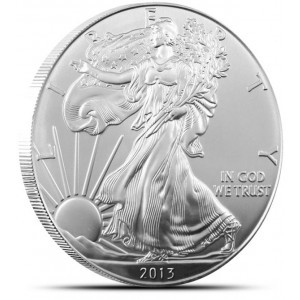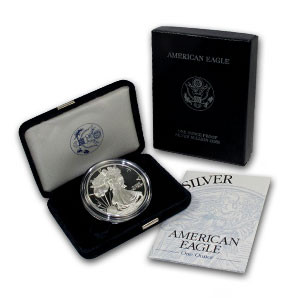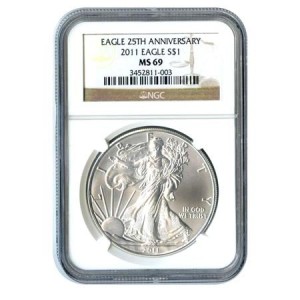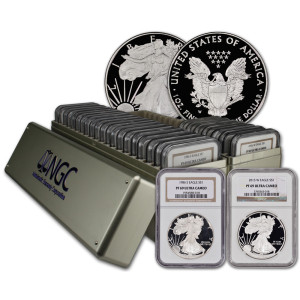Silver American Eagles are a coin that was first produced by the US Mint in 1986. The original coin was minted in only the 1 ounce size and had a face value of 1 US Dollar. The reason behind why the Silver Eagles were ever produced can be attributed to an excess stockpile of silver that was part of the US Defense National Stockpile. At first the government simply tried to sell the silver as is in order to reduce the National deficit but found little success in doing that. Then, in 1985 a bill was proposed that would turn the silver into coins and sell them that way.
Silver Eagles began being produced in October of 1985 and officially went on sale and were issued in September of 1986. Despite no one think it would be, the production of Silver Eagles was a fairly large success right away.
Uncirculated
 Production of the Uncirculated American Silver Eagle was started in 1986 and in the first year there were over 5 million coins produced and issued. The coin was so popular in its initial year that in 1987 production was doubled and over 11 million Eagles made their way to the market. In the following year mintages were reduced back to about what they were in the initial year and for the following 11 years mintage quantities remained around the same level at about 4 to 6 million annually.
Production of the Uncirculated American Silver Eagle was started in 1986 and in the first year there were over 5 million coins produced and issued. The coin was so popular in its initial year that in 1987 production was doubled and over 11 million Eagles made their way to the market. In the following year mintages were reduced back to about what they were in the initial year and for the following 11 years mintage quantities remained around the same level at about 4 to 6 million annually.
In 1999 the amount of Uncirculated Eagles that were minted rose to a little over 7 million and in 2000 it was bumped up further to about 9 million. From 2001 to 2007 anywhere from 8 to 10 million coins were minted annually. That all changed in 2008 when the US Mint decided to produce a whopping 20 million coins and an even more incredible 30 million in 2009. If quantities of coins minted are any indication as to how popular Uncirculated American Silver Eagles are it is clear to see that these coins continue to grow in popularity.
Packaging
Whether you are a collector or investor it is incredibly important to protect your investment. For this reason Uncirculated Eagles are packaged in different protective packaging depending on the quantity of the coin you buy. If you purchase a relatively small number of coins (between 1 and 6) your purchase will be kept safe in a soft plastic, vinyl case. As the number of coins you buy exceeds six your purchase will then be stored and shipped to you in a tube that can hold up to twenty coins.
If you are an avid collector or investor and your purchase of Uncirculated American Silver Eagles exceeds 500 coins you will be shipped your coins in what is known as a monster box. A monster box is nothing more than a bulky protective suitcase that ensures your coin the utmost safety and protection.
Proof
 American Silver Eagles are a coin that has been produced by the US Mint since 1986. The most commonly found version of the coin is the uncirculated version which has been produced in increasing quantities since the first year of production back in 1986. A rarer version of the Silver Eagle is the proof version which undergoes a minting process that is unlike the process undergone by typical, uncirculated coins. The purpose of this article is to not only explain how proof Silver Eagles are minted but also what their value is and why that is the case. Any questions you have about proof Silver Eagles will likely be answered in the following few sections.
American Silver Eagles are a coin that has been produced by the US Mint since 1986. The most commonly found version of the coin is the uncirculated version which has been produced in increasing quantities since the first year of production back in 1986. A rarer version of the Silver Eagle is the proof version which undergoes a minting process that is unlike the process undergone by typical, uncirculated coins. The purpose of this article is to not only explain how proof Silver Eagles are minted but also what their value is and why that is the case. Any questions you have about proof Silver Eagles will likely be answered in the following few sections.
Proof Minting Process
The proof minting process is much more powered by humans than the process for an uncirculated Silver Eagle. The production process starts out by hand feeding burnished blank coins into custom made dies which are then hand-pressed. The proof Silver Eagle is pressed multiple times to give the images on the coin the feel that they are actually levitating above the coin face itself.
After the coins have been pressed they then undergo a white glove inspection to check for any, even the most minor, impurities. After the coin has undergone the scrutinized inspection it is then carefully placed into a protective plastic case where it will likely remain for quite some time. The proof American Silver Eagles are then placed in a satin-lined flip case as to make them even more elegant looking. Inside the satin-lined case is a certificate of authenticity to ensure the buyer that he or she is actually receiving an authentic proof Silver Eagle.
Pricing and Value
The proof Silver Eagle is so much more sought after than the uncirculated version of the coin that you will, in most cases, end up spending double the amount of money on a proof version. The reason for this is that not only do people, namely collectors, want to get their hands on the most stunning version of the Silver Eagle, they also want to purchase the rarest type of the coin. By purchasing a proof version collectors are killing two birds with one stone as they are receiving some of the rarest Silver Eagles as well as the indisputably best quality Eagles.
The value of proof Silver Eagles is undoubtedly much higher than uncirculated Eagles because of the sole fact that there are simply so many fewer proof version minted per year. For example, out of the roughly 41 million Silver Eagles that were produced in 2011, only about 950,000 were proof Eagles. Being that only a fraction of the total amount of Silver Eagles minted were proof Eagles, it is no wonder why they are valued at a much higher level than your average uncirculated Eagle.
Graded
 The American Silver Eagle is a coin that has been produced by the US mint since 1986. Ever since its inception it has been an incredibly popular coin for people not only in the US, but all over the world. For those that have Silver Eagles and would like to know just how valuable their particular coin is, getting the coin graded is an option that many people employ.
The American Silver Eagle is a coin that has been produced by the US mint since 1986. Ever since its inception it has been an incredibly popular coin for people not only in the US, but all over the world. For those that have Silver Eagles and would like to know just how valuable their particular coin is, getting the coin graded is an option that many people employ.
Many collectors only buy graded coins because that is the only way they can be sure of the exact condition of their coin. Coins that are graded are looked at with heavy scrutiny by a professional grading service who will tell you the exact kind of shape the Silver Eagle is in. By purchasing only graded Silver Eagles, collectors can more accurately assess the value of their coins and subsequently how much their coin might go for, should they decide to sell it.
NGC and PCGS
Both the NGC (Numismatic Guaranty Corporation) and the PCGS (Professional Coin Grading Service) are two of the most trusted companies when it comes to grading. While the way that these two companies look at coins in order to grade them is slightly different, the end grade is trusted by people all over the world. The following sections will take a bit of a closer look at just how these companies reach a final grade for coins.
NGC Scale
The NGC scale of coin grading grades coins as being in Mint State to Poor and just about anywhere in between. The actual abbreviations of coin grades and what they stand for are listed, in order of best condition to worst condition, below(each grade also carries with it a number to tell you the degree of each grade the coin falls under):
- MS (Mint State, Uncirculated)-60-70
- AU (About Uncirculated)-50, 53, 55,58
- XF (Extremely Fine)-40, 45
- VF (Very Fine)-20, 25, 30, 35
- F (Fine)-12, 15
- VG (Very Good)-8, 10
- G (Good)-4, 6
- AG (About Good)-3
- FA (Fair)-2
- PR (Poor)-1
PCGS Scale
The PCGS scale is much more expansive than the NGC scale in that each grade is accompanied by a description which explains what the grade exactly means. This differs from the NGC scale in that there are not a variety of number grades attached to each overarching grade. The following is the PCGS scale as it appears on their website in order from highest grade to lowest possible:
- MS/PR-70-As struck, with full strike
- MS/PR-69-Virtually as struck with minuscule imperfections, near full strike necessary
- MS/PR-68+-Virtually as struck with very slight imperfections, the strike must be virtually full. Eye appeal must be very good.
- MS/PR-68-Virtually as struck with slight imperfections, slightest weakness of strike allowed
- MS/PR-67+-Virtually as struck with very minor imperfections, very well struck with attractive eye appeal
- MS/PR-67-Virtually as struck with minor imperfections, very well struck
- MS/PR-66+-Very few minor marks/hairlines not in focal areas, very good strike with superior eye appeal
- MS/PR-66-Few minor marks/hairlines not in focal areas, good strike
- MS/PR-65+-Very minor marks/hairlines though none in focal areas, above average strike and eye appeal
- MS/PR-65-Minor marks/hairlines though none in focal areas, above average strike
- MS/PR-64+-Very few marks/hairlines or a couple of heavier ones, strike should be average or above. Superior eye appeal.
- MS/PR-64-Few marks/hairlines or a couple of severe ones, strike should be average or above
- MS/PR-63+-Average number of marks/hairlines, strike will be close to average. Good eye appeal for grade.
- MS/PR-63-Moderate number/size marks/hairlines, strike may not be full
- MS/PR-62+-No wear. Still slightly above number of marks/hairlines, strike may not be full. Attractive eye appeal for grade.
- MS/PR-62-No wear. Slightly less marks/hairlines, strike may not be full
- MS/PR-61-No wear. Multiple heavy marks/hairlines, strike may not be full
- MS/PR-60-No wear. May have many heavy marks/hairlines, strike may not be full
- AU-58+-Full detail with the barest trace of friction on the highest points. Superior eye appeal.
- AU-58-Full detail with only slight friction on the high points
- AU-55+-Full detail with slight friction on less than 1/2 of surface, on high points. Eye appeal is good.
- AU-55-Full detail with friction on less than 1/2 surface, mainly on high points
- AU-53+-Full detail with friction on only 1/2 of surface, extremely slight flatness on high points. Positive eye appeal.
- AU-53-Full detail with friction over 1/2 or more of surface, very slight flatness on high points
- AU-50+-Full detail with friction over most of the surface, very slight flatness on high points. Good eye appeal.
- AU-50-Full detail with friction over most of the surface, slight flatness on high points
- EF-45+-Detail is complete with a few high points flat. Superior eye appeal.
- EF-45-Detail is complete with some high points flat
- EF-40-Detail is complete with most high points slightly flat
- VF-35-Detail is complete but worn with high points flat
- VF-30-Almost complete detail with flat areas
- VF-25-Slightly more definition in the detail and lettering
- VF-20-Some definition of detail, all lettering full and sharp
- F-15-Slightly more detail in the recessed areas, all lettering sharp
- F-12-Some deeply recessed areas with detail, all lettering sharp
- VG-10-Design worn with slight detail, slightly clearer
- VG-8-Design worn with slight detail
- G-6-Rims complete with flat detail, peripheral lettering full
- G-4-Slightly worn rims, flat detail, peripheral lettering nearly full
- AG-3-Worn rims but most lettering is readable though worn
- FR-2-Mostly worn, though some detail is visible
- PO-1-Identifiable date and type
Costs and Values
As logic would suggest the higher the grade of coin, whether it is NGC or PCGS grades, the more you can expect to pay for the coin. Some people would prefer to buy a coin graded by one organization over another, but at the end of the day the differences are really negligible.
In general, graded American Silver Eagles will cost more than your average, uncirculated Eagle because the grading process itself costs money. More often than not the graded Eagles you will find will be in better condition simply because people tend to take care of these particular coins, but older versions of the coin will have varying conditions as they have been around much longer.
Complete Sets
 American Silver Eagles are coins that have been produced by the US Mint since 1986. Originally produced as a way to help fight US debt, these coins rose to popularity almost as soon as they were released. Ever since the late 1980s the coins have become heavily sought after to the point where annual numbers of coins minted has grown consistently.
American Silver Eagles are coins that have been produced by the US Mint since 1986. Originally produced as a way to help fight US debt, these coins rose to popularity almost as soon as they were released. Ever since the late 1980s the coins have become heavily sought after to the point where annual numbers of coins minted has grown consistently.
Now, more than 20 years after Silver Eagles first hit the market, they are being sold in a way that is unlike ever before, in complete sets. Complete Silver Eagle sets contain a Silver Eagle from every year, starting in 1986 and continuing up until today. This article will explain how these sets are sold as well as how much you might be expected to pay for them.
How Silver Eagle Sets are Sold
Complete Silver Eagle sets are most often packaged in a small treasure chest-like box. They can also be found in rectangular tubes with a slot for each year’s coin. Because collectors and investors want to keep their coins in the best possible condition, they are almost always encased in plastic, even inside the larger case. An additional security measure that you will find on a lot of complete sets of Silver Eagles is a felt lining on the inside of the case they come in. Even if your coins, for whatever reason, are not encased in plastic, the felt lining gives them extra security from wear and tear during transit.
Some Silver Eagle sets contain graded versions of every coin from 1986 up until today. Having every coin graded makes your life easier as you are able to assess the quality of each and every Silver Eagle, though if the coins are brand new when you purchase them most of the grades will be the same.
Additionally, you will also find Silver Eagle sets that contain only proof Silver Eagles. Proof Eagles are much rarer and because of this you will end up paying much more for them than your typical uncirculated sets. To put in perspective just how rare proof Silver Eagles are in comparison to the uncirculated version of the coin, in 2011, out of the nearly 41 million total Silver Eagles that were produced, only a little over 900,000 were proof versions. That being said, most collectors strive to find the rarest versions of coins and a proof complete set is about as rare as you can get as far as Silver Eagles go. It is important to note that in 2009 there were no proof Silver Eagles minted.
Value and Pricing of Silver Eagle Sets
How much you are going to pay for a complete set of Silver Eagles really depends on the type of Eagles that are in the set, and whether or not they are graded.
If you are going to purchase an ungraded, uncirculated set of Silver Eagles you will pay far less than if the set contains only proof coins. Should the coins be graded you can expect to pay more than an ungraded set as the process of getting their condition appraised costs money in and of itself.
Basically, the most expensive set of Silver Eagles is going to be the proof version with every coin graded. An ungraded proof set will cost slightly less, with the cheapest of all being an uncirculated set of Eagles without grades. Of course you can always get the coins graded yourself, but this procedure can be time consuming and costly depending on how you about doing it.
Where to Buy Complete Sets
Silver Eagle complete sets are a hot item at any time of the year and tend to sell out as quickly as dealers stock them. A simple search online will yield you a number of different dealers who are currently offering or have offered these sets. eBay is a popular place to search for Silver Eagle sets but whenever you use eBay to buy precious metals it is imperative that you only buy from a trusted seller as people, time and time again, fall victim to scammers.
Brick and mortar dealers of precious metals, such as coin shops, are another place to look for Silver Eagle sets, but because of their popularity you need to act fast as they typically sell out quickly. There is not one, solid outlet to purchase complete sets but by doing some thorough research and putting in the extra effort you will undoubtedly be able to find the set you are looking for.





